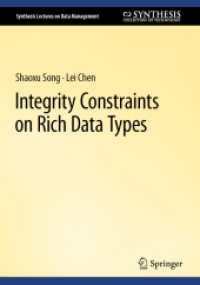- ホーム
- > 洋書
- > 英文書
- > Science / Mathematics
Full Description
Inspired by the community behaviors of animals and humans, cooperative control has been intensively studied by numerous researchers in recent years. Cooperative control aims to build a network system collectively driven by a global objective function in a distributed or centralized communication network and shows great application potential in a wide domain. From the perspective of cybernetics in network system cooperation, one of the main tasks is to design the formation control scheme for multiple intelligent unmanned systems, facilitating the achievements of hazardous missions - e.g., deep space exploration, cooperative military operation, and collaborative transportation. Various challenges in such real-world applications are driving the proposal of advanced formation control design, which is to be addressed to bring academic achievements into real industrial scenarios. This book extends the performance of formation control beyond classical dynamic or stationary geometric configurations, focusing on formation maneuverability that enables cooperative systems to keep suitable spacial configurations during agile maneuvers. This book embarks on an adventurous journey of maneuverable formation control in constrained space with limited resources, to accomplish the exploration of an unknown environment. The investigation of the real-world challenges, including model uncertainties, measurement inaccuracy, input saturation, output constraints, and spatial collision avoidance, brings the value of this book into the practical industry, rather than being limited to academics.
Contents
1. Introduction
Part I Layered Affine Formation Control
2. Multi-Layer Formation Control of Multi-Agent Systems
3. Layered Affine Formation Control of Networked Uncertain Systems: a Fully Distributed Framework over Directed Graphs
4. Cooperative Affine Circumnavigation of Networked Microsatellites
5. Fully Distributed Cooperative Affine Circumnavigation of Networked Unmanned Aerial Vehicles
Part II Formation Control in Constrained Space
6. Formation Potential Field for Trajectory Tracking Control of Multi-Agent Systems in Constrained Space
7. Neural-Network-Based Switching Formation Tracking Control of Multi-Agent Systems with Uncertainties in Constrained Space
8. Event-Triggered Coordination for Formation Tracking Control in Constrained Space with Limited Communication
9. Vision-Based Leader-Follower Formation Control of Multi-Agent Systems with Visibility Constraints
10. Conclusion








